Thermoplastic polycarbonate is placed as a transparent fence that lets light rays into the greenhouse. At the same time, the coating protects the interior from the cold. The material is produced in different thicknesses and sizes, so it is selected in each case according to the required parameters. You can easily assemble a polycarbonate greenhouse with your own hands, since the process is technologically simple, does not require special knowledge and experience.
- Features of polycarbonate
- Pros and cons of the material
- Types of greenhouse structures
- Comparison of homemade and ready-made greenhouse
- Frame material
- Wood
- Corrugated pipe and steel angle
- Galvanized profiles
- Varieties of polycarbonate
- Types of polycarbonate for the greenhouse
- Preparatory work
- Foundation types
- Reinforced concrete tape
- Concrete-brick (concrete-lumber)
- Beam type for polycarbonate greenhouse
- Pile-grillage
Features of polycarbonate
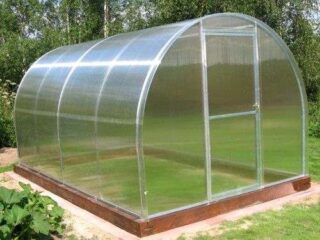
The material without a protective layer on the surface is unstable to ultraviolet light, deteriorates in the sun, therefore, during production, a film is applied by extrusion or by spraying. Sometimes stabilizers are mixed in bulk, this type is the most productive, but it is expensive.
The thickness of the polycarbonate affects the performance:
- thermal protection;
- sound absorption;
- bending radius.
Light transmittance depends on the color of the sheets, for example, bronze delays half of the rays, compared to transparent. The weight of the material also depends on the thickness and internal structure of the voids.
Pros and cons of the material
The thermoplastic profile on the frame is heat-resistant, resists impacts, conducts light, does not depend on the weather. At low temperatures brittleness appears, but such conditions do not exist in Russia. The strength and hardness of polycarbonate are comparable to those of aluminum.
Positive qualities for a greenhouse:
- the lightness of the walls allows you to make a less massive foundation;
- density approaches that of glass with less weight;
- sheets are easy to cut and install.
When a fire appears, the panels melt rather than burn, while the softened mass does not spread. The sheet cracks from the blow, but the fragments do not fall out of it, remain in the product.
Lack of the need for careful transportation and installation, so as not to damage the protective film.
Types of greenhouse structures
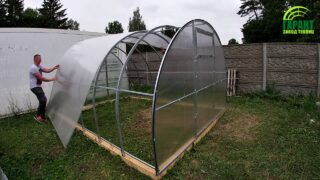
The owner chooses the type of greenhouse in accordance with the purpose of the building and financial capabilities. What matters is the seasonality of use, the type of crops grown.
Greenhouses are:
- arched;
- with a drip roof;
- wall-mounted or single-slope;
- gable.
Arched ones have a semicircular overlap, and drip ones consist of two surfaces, curved so that an acute-angled ridge edge is obtained at the top. Wall-mounted uses the wall of the building for one side, and the ramp is directed perpendicular to the sun's rays for more illumination. Gable ones resemble a rectangular house, and for manufacturing, bending of the supporting arcs is not required, as for an arch.
Comparison of homemade and ready-made greenhouse
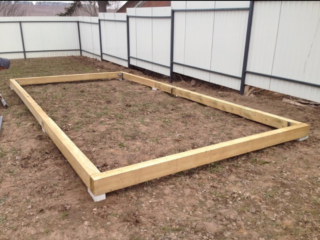
The advantages of a do-it-yourself greenhouse made of wood and polycarbonate are that the owner selects the material of the frame covering, the structure of the foundation at his own discretion. The construction is carried out by himself, without overpaying the craftsmen.
Disadvantages of self-manufacturing;
- you need to prepare a project, choose a greenhouse device;
- make a correct drawing, develop a diagram;
- purchase materials;
- collect and install a greenhouse on the site.
A purchased structure can be delivered quickly according to the instructions, and there are no preparatory processes. TO
Frame material
The skeleton of the structure must be reliable and durable to withstand the loads from wind and snow (winter version). Stable support extends the life of the greenhouse.
Materials for the frame are used:
- wooden beam;
- plastic pipes;
- metal shaped pipes;
- galvanized profile.
Each material is distinguished by the peculiarities of manufacture and operation.
Wood
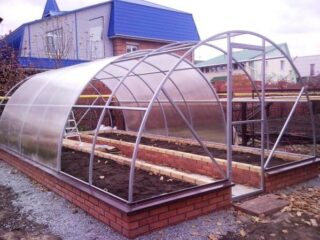
New building materials appear, but the demand for wood is not decreasing. The material is affordable, it is sold inexpensively, so it is often used for the frame.
Arguments in favor of a tree:
- environmental friendliness - no toxic components are released when heated in the sun;
- ease of installation, handling;
- sufficient strength for the construction of a greenhouse;
- durability when using protection methods.
The disadvantages include rotting from moisture, for example, in rain or snow.
Wood ignites and burns in a fire. The disadvantages are eliminated by impregnating the elements with antiseptics, fire retardants before fixing them in the frame.
Corrugated pipe and steel angle
The durable metal frame is resistant to single and continuous loads. A profiled pipe is taken with a rectangular or square cross section, so that it is more convenient to connect by welding or bolting. The corner is used No. 45 - 75, depending on the scale of the building.
The advantages of a metal frame:
- the possibility of self-welding and manufacturing of arches;
- compatibility with polycarbonate sheets;
- does not burn.
Metal has disadvantages in that it must be painted regularly to protect it from corrosion, and before that it must be coated with a rust preventive agent. The structure weighs more than a timber greenhouse, so a good foundation is needed.
Galvanized profiles
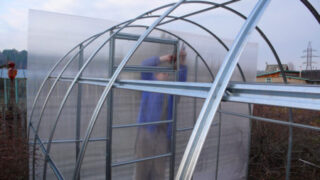
A suitable option for a greenhouse, since the zinc layer protects the surface from destruction under the influence of atmospheric moisture and from the ground. The profiles do not require preliminary processing, it is easy to connect them, for this they use self-tapping screws for metal.
Advantages of a galvanized profile:
- the lightness of the elements reduces the total mass of the structure transferred to the foundation;
- square section facilitates docking, easy to fix polycarbonate;
- there are no uneven bends, deformations on the surface, no adjustment is required.
Galvanized profiles do not need painting after installation, the frame with such a coating will last 20 - 25 years without destruction.
Varieties of polycarbonate
Distinguish between monolithic and cellular polycarbonate. The choice of material is influenced by the technical characteristics of each type.
When designing, take into account the properties:
- density of panels;
- sheet thickness, available bending radius;
- honeycomb configuration and strength indicators;
- color and UV protection.
Monolithic panels allow a lot of light to pass through, but also conduct heat, so they are not installed on heated home buildings. Solid sheets weigh a lot. Cellular polycarbonate is a suitable option, it corresponds to the parameters of use. The quality of raw materials and the structure of the honeycomb affect the cost of the sheets.
Types of polycarbonate for the greenhouse

Polycarbonate 4 mm is used for summer types of greenhouse, since the material does not protect from the cold. Polypropylene sheets with a thickness of 6 mm can be used in autumn and spring greenhouses, but such panels do not reach the characteristics of a glass unit.
8 mm sheets are used in the southern regions in winter, this thickness allows you to keep heat inside the greenhouse. In such a structure, a door and windows are made that will open. The most suitable is considered to be polycarbonate plates with a thickness of 10 mm. The material bends to the required radius and maintains an acceptable indoor microclimate.
Preparatory work
The greenhouse is placed in a place that is most illuminated by the sun.The building should not be located in a low, humid place of the site.
Before construction, a project is made, in which they indicate:
- overall dimensions of the structure, for this, axes are applied along the line of the frame racks;
- the height of the vertical parts, the location of crossbars, corner braces;
- size of polycarbonate sheets, calculation of the amount of materials;
- provide a frame for opening openings.
On the construction site, the fertile soil layer is removed. The axes of the base of the greenhouse are marked on the spot; for this, a cord and pegs are used. For the strip base, parallel lines are made, indicating the width of the digging. The land is partially left for backfill, the rest is taken away.
Foundation types
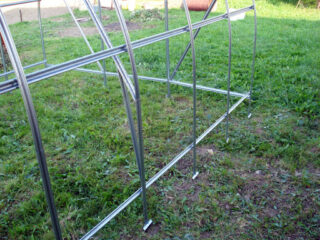
Small greenhouses can be built without a foundation, they are located on girders, beams, just on the ground. But for full-size structures, a foundation is required.
It performs the following functions:
- contributes to the stability of the skeleton, protects against distortions and destruction of polycarbonate;
- protects the interior from the penetration of rodents, the spread of weeds;
- improves the thermal insulation of a building if it is insulated from moisture and cold.
Refusal from the foundation to save materials and time will subsequently affect the durability of the structure. A strip base, concrete brick, is built under the structure, a foundation is made of a bar, a pile-grillage is chosen. An exception is made for assembling a polycarbonate greenhouse for portable and collapsible models, where the base is not provided.
Reinforced concrete tape
Prepare the site, mark out the dimensions of the base. The trench is dug by hand, or an excavator is ordered. The depth of the laying is calculated in advance, taking into account the loads, they usually dig at 70 - 80 cm. The width is chosen for the bayonet of the shovel, if they do not intend to make a wooden formwork, but concrete will be poured into the trench.
Step by step order:
- they clean the bottom of the trench, arrange sand-gravel bedding (10 and 15 cm);
- the bottom and walls of the trenches are lined with roofing material; below, reinforcement is laid longitudinally on the linings;
- concrete is prepared 1: 3: 5 (cement, sand, crushed stone), poured into a trench.
The surface is covered with polyethylene, or a layer of wood sawdust is placed. The shavings are watered every day so that the concrete does not dry out.
Concrete-brick (concrete-lumber)
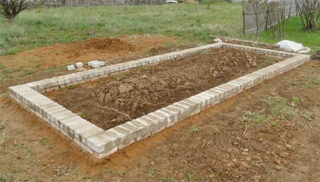
It is a combined structure, the bottom of which is made with concrete, and the top is built of bricks or thick wooden beams.
Work order:
- make a trench similar to the tape type;
- before pouring, put embedded parts 15 cm above the concrete surface: studs - for a bar, pieces of reinforcement - for brickwork;
- concrete is poured and the surface is looked after.
Holes are drilled in the timber and the run is placed on the studs. The corners of the wooden beams are joined in half the wood. The brick is used ceramic red, and the protrusions of the reinforcement are placed between the individual stones, and they are sealed with mortar. Between the foundation and the timber, waterproofing is done with two layers of roofing material on bitumen mastic.
Beam type for polycarbonate greenhouse
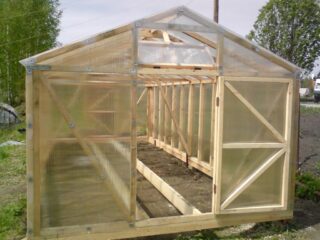
The option is used for temporary structures, since such a foundation will last 2 - 3 years. For the beam, take a block of wood with a section of 100 x 100 mm, it can be made composite of boards. The wood in the ground is exposed to moisture, so the element is wrapped in two layers of roofing material before being installed in the installation position.
Manufacturing processes:
- for installation, they dig a trench according to the size of the bar;
- leave a place in depth for adding sand and gravel;
- lay waterproofing, install a bar;
- join the corners of the beam, close the insulating layer;
- side pockets are covered with rubble, soil, rammed.
A strapping is fixed to the bar, additional insulation from moisture is made between it and the beam. Such a foundation is suitable for places with low soil moisture levels.
Pile-grillage
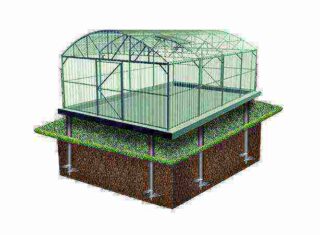
Supports of this type will not protect the greenhouse from freezing, but will serve as a solid support for the wall frame. For greenhouse buildings, concreted, driven or screwed piles are used. Driving requires special equipment, and the first and third options can be done independently.
Supports are concreted in the ground as a columnar base. They dig holes, arrange a pillow at the bottom, then put a metal frame and concrete in the ground. After that, the pillars are connected with a beam (grillage) so that the individual supports are not squeezed upward when the soil moves.
Rolling piles are purchased at the store. There are blades at the lower end. They are marked at the corners of the building, and they are placed around the perimeter every 2 meters. For twisting, a device is prepared that is used by two people. A grillage is also welded to the installed piles to unite the structure into one whole.








